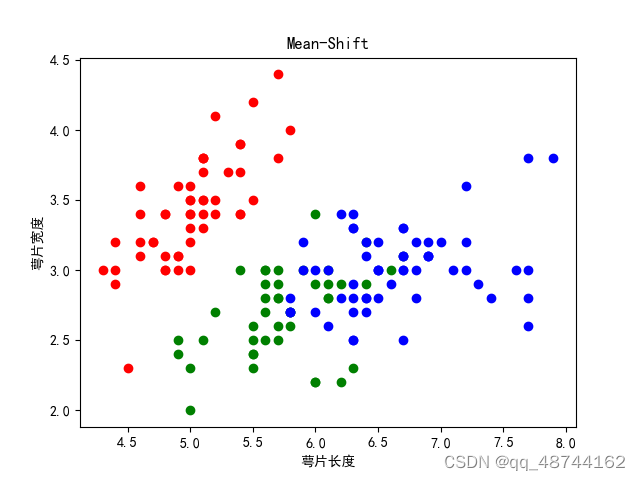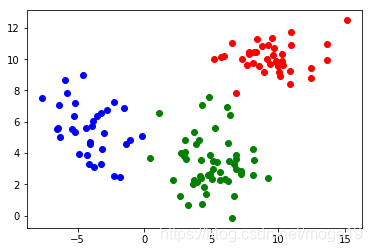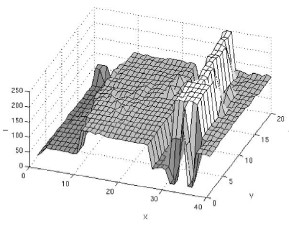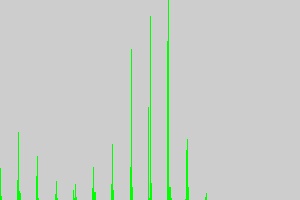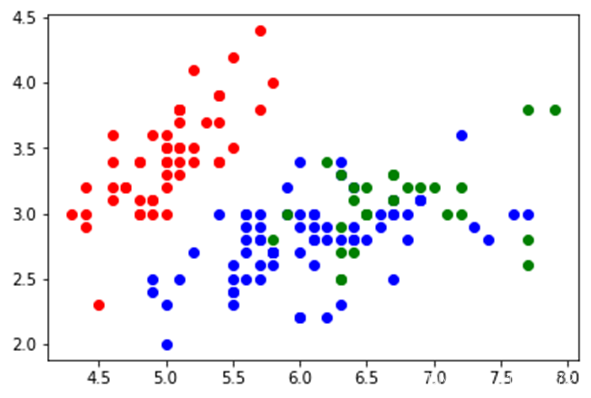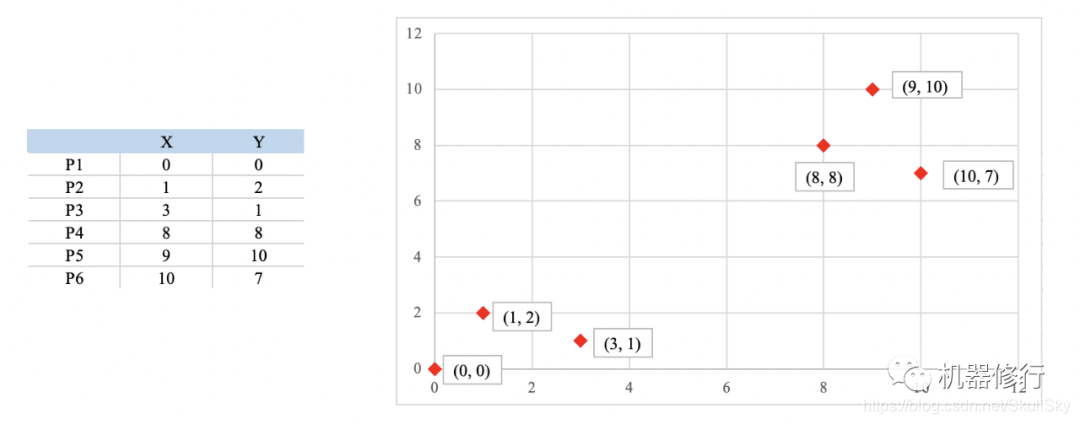Mean Shift聚类算法
1. 基本原理
对于Mean Shift算法,是一个迭代得步骤,即每次迭代的时候,都是找到圆里面点的平均位置作为新的圆心位置。说的简单一点,使得圆心一直往数据密集度最大的方向移动。

2. 基本的Mean Shift向量形式
对于给定的 d d d维空间 R d R^d Rd中的 n n n个样本点 x i , i = 1 , 2 , . . . , n x_i, i=1,2,...,n xi,i=1,2,...,n,对于空间中的任意点 x x x的mean shift向量的基本形式可以表示为:
M h ( x ) = 1 k ∑ x i ∈ S h ( x i − x ) M_h(x)=\frac {1}{k}\sum_{x_i \in S_h}(x_i-x) Mh(x)=k1xi∈Sh∑(xi−x)
其中, k k k表示的是数据集中的点到 x x x小于球半径 h h h的数据点的个数, S h S_h Sh是一个半径为 h h h的高维球区域, S h S_h Sh的定义为:
S h ( x ) = ( y ∣ ( y − x ) ( y − x ) T ≤ h 2 ) S_h(x)=(y|(y-x)(y-x)^T \leq h^2) Sh(x)=(y∣(y−x)(y−x)T≤h2)
这样的一种基本的Mean Shift形式存在一个问题:在 S h S_h Sh区域内,每一个点对 x x x的贡献都是一样的,而实际上,这种贡献与 x x x到每一个点之间的距离是相关的,同时,对于每一个样本,其重要程度也不一样。
3. 改进的Mean Shift向量形式
假设在 S h S_h Sh范围内,为了使得每一个样本点 x i x_i xi对于样本 x x x的贡献不一样,向基本的Mean Shift向量形式中增加核函数,得到如下的改进的Mean Shift向量形式:
M h ( x ) = ∑ x i ∈ S h [ K ( x i − x h ) ( x i − x ) ] ∑ x i ∈ S h [ K ( x i − x h ) ] M_h(x)=\frac {\sum_{x_i \in S_h}[K(\frac {x_i-x} {h})(x_i-x)]} {\sum_{x_i \in S_h}[K(\frac {x_i-x} {h})]} Mh(x)=∑xi∈Sh[K(hxi−x)]∑xi∈Sh[K(hxi−x)(xi−x)]
其中 K ( x i − x h ) K(\frac {x_i-x} {h}) K(hxi−x)是高斯核函数,其函数形式如下:
K ( x 1 , x 2 ) = K ( x 1 − x 2 h ) = 1 2 π h e − ( x 1 − x 2 ) 2 2 h 2 K(x_1,x_2)=K(\frac {x_1-x_2} {h})=\frac {1} {\sqrt {2\pi}h}e^{-\frac {(x_1-x_2)^2}{2h^2}} K(x1,x2)=K(hx1−x2)=2πh1e−2h2(x1−x2)2
其中, h h h称为带宽bandwidth,即高维球区域 S h S_h Sh的半径,不同带宽的核函数如下所示:

从图像可以看出,当带宽 h h h一定时,样本点之间的距离越近,其核函数的值越大;当样本点之间的距离相等时,随着高斯核函数的带宽 h h h的增大,核函数的值在减小
4. Mean Shift聚类流程
-
在未被标记的数据点中随机选择一个点作为中心
center; -
找出离
center距离在bandwidth之内的所有点,记做集合 M M M,认为这些点属于簇 c c c。同时,把这些求内点属于这个类的概率加1,这个参数将用于最后步骤的分类 -
以
center为中心点,计算从center开始到集合 M M M中每个元素的向量,将这些向量相加,得到向量shift -
center = center+shift。即center沿着shift的方向移动,移动距离是||shift|| -
重复步骤2、3、4,直到
shift的大小很小(就是迭代到收敛),记住此时的center。注意,这个迭代过程中遇到的点都应该归类到簇 c c c。 -
如果收敛时当前簇 c c c的
center与其它已经存在的簇 c 2 c_2 c2中心的距离小于阈值,那么把 c 2 c_2 c2和 c c c合并。否则,把c作为新的聚类,增加1类。 -
重复1、2、3、4、5, 6直到所有的点都被标记访问
-
分类:根据每个类,对每个点的访问频率,取访问频率最大的那个类,作为当前点集的所属类。
5. 实例演示
import numpy as np
import matplotlib.pyplot as plt from sklearn import cluster, datasets
from sklearn.preprocessing import StandardScalernp.random.seed(0)# 构建数据
n_samples = 1500
noisy_circles = datasets.make_circles(n_samples=n_samples, factor=0.5, noise=0.05)
noisy_moons = datasets.make_moons(n_samples=n_samples, noise=0.05)
blobs = datasets.make_blobs(n_samples=n_samples, random_state=8)data_sets = [(noisy_circles,{"quantile": 0.3}),(noisy_moons,{"quantile": 0.3}), (blobs, {"quantile": 0.3})
]
colors = ["#377eb8", "#ff7f00", "#4daf4a"]plt.figure(figsize=(15, 5))for i_dataset, (dataset, algo_params) in enumerate(data_sets):# 模型参数params = algo_params# 数据X, y = datasetX = StandardScaler().fit_transform(X)# 设置bandwidthbandwidth = cluster.estimate_bandwidth(X, quantile=params['quantile'])# 创建Mean Shiftms = cluster.MeanShift(bandwidth=bandwidth, bin_seeding=True)# 训练ms.fit(X)# 预测y_pred = ms.predict(X)y_pred_colors = []for i in y_pred:y_pred_colors.append(colors[i])plt.subplot(1, 3, i_dataset+1)plt.scatter(X[:, 0], X[:, 1], color=y_pred_colors)plt.show()

6. Mean Shift小结
优点:不用选择簇的数量;缺点:固定了bandwidth




